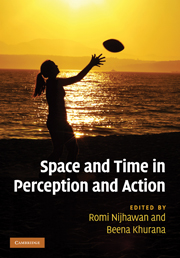Book contents
- Frontmatter
- Contents
- List of contributors
- Acknowledgments
- 1 Space and time: the fabric of thought and reality
- Part I Time–space during action: perisaccadic mislocalization and reaching
- Part II Temporal phenomena: perception
- Part III Temporal phenomena: binding and asynchrony
- 13 Dynamics of visual feature binding
- 14 How does the timing of neural signals map onto the timing of perception?
- 15 Mechanisms of simultaneity constancy
- 16 Relative timing and perceptual asynchrony
- 17 The time marker account of cross-channel temporal judgments
- 18 Simultaneity versus asynchrony of visual motion and luminance changes
- Part IV Spatial phenomena: forward shift effects
- Part V Space–time and awareness
- Index
- References
14 - How does the timing of neural signals map onto the timing of perception?
from Part III - Temporal phenomena: binding and asynchrony
Published online by Cambridge University Press: 05 October 2010
- Frontmatter
- Contents
- List of contributors
- Acknowledgments
- 1 Space and time: the fabric of thought and reality
- Part I Time–space during action: perisaccadic mislocalization and reaching
- Part II Temporal phenomena: perception
- Part III Temporal phenomena: binding and asynchrony
- 13 Dynamics of visual feature binding
- 14 How does the timing of neural signals map onto the timing of perception?
- 15 Mechanisms of simultaneity constancy
- 16 Relative timing and perceptual asynchrony
- 17 The time marker account of cross-channel temporal judgments
- 18 Simultaneity versus asynchrony of visual motion and luminance changes
- Part IV Spatial phenomena: forward shift effects
- Part V Space–time and awareness
- Index
- References
Summary
Summary
Different features of stimuli are processed in the central nervous system at different speeds. However, such neural time differences do not map directly onto perceptual time differences. How the brain accounts for timing disparities to correctly judge the temporal order of events in the world is the temporal binding problem. I weigh physiological data against new psychophysical findings both within and between modalities. The essence of the paradox is that the timing of neural signals appears, at first blush, too variable for the high accuracy of the psychophysical judgments. I marshal data indicating that ∼80 msec is an important duration in perception and make the novel suggestion that this number is directly mirrored in the physiology. In recordings from several areas of the primate visual system, the difference between the slowest and fastest latencies based on luminance contrast is 80 msec. If the rest of the brain wants to time outside stimuli correctly, it must account for the fact that the earliest stages of the visual system spread signals out in time. I suggest that the brain waits for the slowest information to arrive before committing to a percept. This strategy only applies to visual awareness; in contrast, the motor system may form its reactions based on the first incoming spikes.
Introduction
One goal of modern neuroscience is to relate physiological data to perception (Eagleman 2001). How do spikes recorded from single neurons map onto object recognition, brightness perception, or timing judgments?
Information
- Type
- Chapter
- Information
- Space and Time in Perception and Action , pp. 216 - 231Publisher: Cambridge University PressPrint publication year: 2010
References
Accessibility standard: Unknown
- 10
- Cited by
